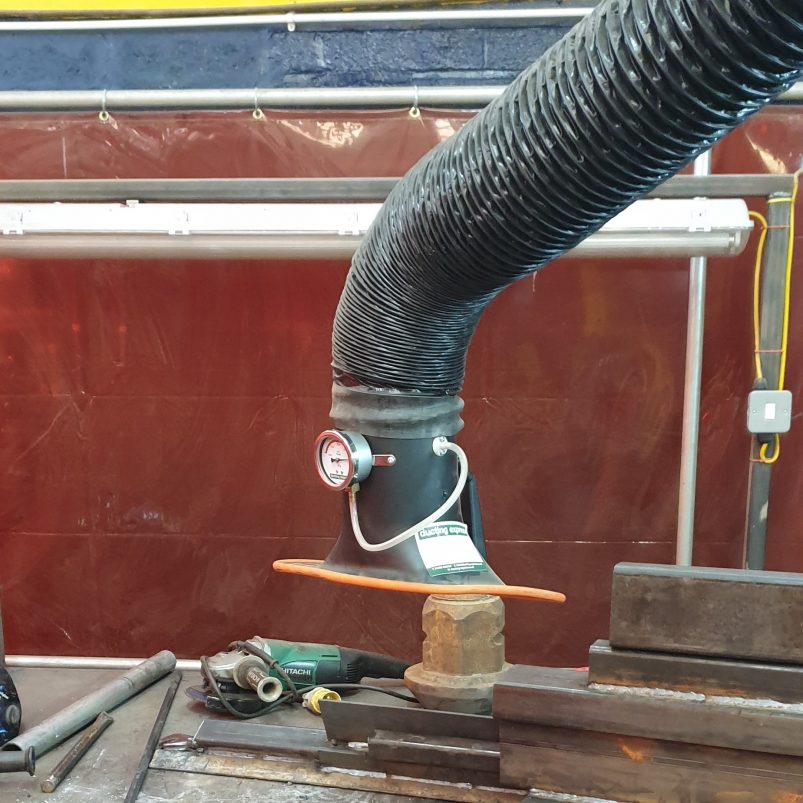The legal requirements of whether or not you should have an airflow indicator fitted to an LEV system is often unclear. In this blog Ducting Express are going to answer some of the most common questions we get asked about LEV indicators.
What is an LEV indicator?
An LEV airflow indicator is a visual aid which can be quickly and easily fitted to your Local Exhaust Ventilation system. They measure the airflow and ensure your system is working correctly. As an employer you can easily remove the worry and risk of an unsafe working environment by having an airflow monitor fitted.
LEV Indicators come in different types, shapes, sizes and are often known by different names. Depending on the person or company you are speaking to they can be referred to as indicators, gauges or monitors.
Do I need to fit airflow indicators to my system?

This is where it gets a little confusing. The HSE’s LEV FAQ’s section of their website states “There isn’t a specific legal requirement to have airflow indicators or similar fitted to an extraction. But as an employer you do by law have to make sure your LEV system keeps working properly.”. So why should I fit them to my extraction hood if they aren’t a legal requirement? I hear you ask.
Let’s take a look at the HSE’s statement again. No, there is not a legal requirement to have an airflow indicator fitted. However, the key part of their statement is the second part, in that as an employer you are legally required to make sure your LEV system keeps working properly.
Another regulation in which requires you to ensure that an LEV system keeps working properly is The Control of Substances Hazardous to Health Regulations 2002 (COSHH). This regulation states that, you, as an employer are responsible for taking effective measures to control exposure to hazardous substances and protect employees health.
Currently an LEV Indicator is the only method of checking airflow that will show the operator or supervisor immediately if there’s a problem. The HSE’s LEV guidance HSG 258 also recommends that these are fitted.
“Employers should make sure that LEV systems continue to work properly.
There are several ways of checking this, such as using an anemometer, dust lamp
or smoke tracer – with the work process running. The simplest way is probably to
use an airflow indicator. This will give the operator a simple indication that the hood
is working properly.” – HSG 258
In a court of law, you would need to be able to convince a Judge that it was not accepted practice and ‘reasonably practicable’ for hood indicators to be fitted.
How do I install an LEV gauge?
Though most LEV Indicators are quick and simple to install they can still be incorrectly installed. Any person installing airflow indicators must be ‘competent’ with an understanding of LEV best practices and principles of design.
An analogue LEV gauge will need to show the operative clearly whether the airflow is adequate. The person installing an LEV gauge will be required set-up airflow zones, using stickers provided, according to the system design (red: inadequate airflow and green: adequate airflow) . It is not uncommon to see LEV installations with gauge ranges which are inappropriate for the system pressure and/or have the incorrect red and green regions.
Electronic LEV monitors may be a simpler solution, as often they often cover a broad range of measurement, nevertheless they will still require correct installation, calibration and run on batteries (we recommend to change these during your periodic LEV test).
Benefits of airflow indicators
Having an LEV indicator fitted to your LEV system has many benefits; these include:
- Inexpensive and easy to install
- An immediate method of checking airflow
- Limits downtime
- Removes the worry and risk of an unsafe working environment

LEV Testing
So you have installed airflow indicators to your extraction hoods. That doesn’t mean that you can now just rely on the feedback from operatives viewing the indicators to determine that the LEV control is adequate for the process.
You have a legal requirement under the CoSHH (Control of Substance Hazardous to Health) Regulations 2002 to ensure that measures you use to protect employee’s health, in the form of extraction systems (LEV) are maintained in efficient and effective working order. In addition to your newly fitted airflow monitors, you must also have thorough examination and testing of the LEV controls, at least every 14 months.
If you would like an LEV monitor installed during your next LEV Test please let us know when getting booked in. One of our skilled LEV engineers can quickly and easily install airflow indicators to your system during their visit; ensuring they are installed correctly.
Still have more questions about LEV Indicators, Local Exhaust Ventilation systems & LEV Testing? Give Ducting Express a call at 01455 616 444, a member of our experienced team can provide you with further information suited to your workshop’s requirements.
